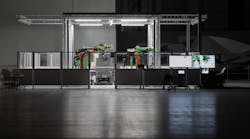Microfactories, not Gigafactories, Will Build It Back Better
If you buy Elon Musk’s vision of reinventing manufacturing in America, that means the bigger the better. His multiple gigafactories are squarely in the tradition of Henry Ford’s 16-million square foot, vertically integrated Rouge River plant. But that was nearly 100 years ago.
For some of us, the way to achieve the Biden Administration’s “Build Back Better” challenge is a radical shift, to smaller, ultra-efficient, easily built plants nearer the point of sale and use: microfactories.
The final nail in the coffin of conventional large-scale global manufacturing was the horrific sight of the gargantuan Evergreen Given container ship stuck in the Suez Canal.
That came after the COVID crisis disrupted manufacturing and shipping from China for months, and corporate leaders declared that global warming must be dealt with through drastic changes. “A bold 2030 target is needed to catalyze a zero-emissions future, spur a robust economic recovery, create millions of well-paying jobs and allow the U.S. to ‘build back better’ from the pandemic,'' more than 300 U.S. businesses and investors stated in a letter to President Joe Biden. “New investment in clean energy, energy efficiency and clean transportation can build a strong, more equitable and more inclusive American economy,'' they wrote.
The solution to all of these problems—scale, efficiency, and location—may be in the approach of a British startup, Arrival, which is moving with astonishing speed toward opening its first three plants, in England; Rock Hill, South Carolina; and Charlotte, North Carolina.
When operational, the plants will manufacture electric delivery vans and transit buses challenging conventional assumptions about vehicle design and production—and underscoring exactly how much the Industrial Internet of Things (IIoT) allows a radical departure from conventional manufacturing. The resulting benefits will include higher operating efficiency, reduced supply chains, and lower environmental impact.
Perhaps most startling is the factories' size, or lack thereof. Instead of a massive plant taking years to design, permit and construct, the Arrival microfactories are so modular, small, and automated that they only require 200,000 square feet, and can actually be assembled in existing, vacant industrial warehouses, rather than requiring a new building. Unlike conventional plants that may take 2 years to be operational, they are slated to be up, running, and revenue producing in as little as six months.
Inside, robotic, modular work stations replace the conveyor belt. My bet is that, once fully functional, the IoT-based automated production system will even beat Siemens’ “factory of the future” record, 99.99885%
The microfactories’ efficiency is also due to totally rethinking vehicle design. The first thing you notice about both the Arrival delivery vans and buses is the totally flat floor, which sits on a “skateboard” undercarriage of axles, battery, and motors. The frame itself is made of lightweight extruded aluminum, not stamped metal. The body is a picture of efficiency: instead of massive presses needed to stamp metallic body parts, their bodies are made of woven composite with colors mixed in, so no paint stations are needed (and scratches are hidden because the color isn’t just superficial). Instead of scrap that contributes to environmental impact, inefficiency, and costs, any left-over pieces of the vehicles’ bodies can be ground up and used again right in the factory.
The robotic machinery can be easily reprogrammed for design changes, and even for mass customization that will increase customer satisfaction and revenues.
The only negative factor in this new approach is that their small size and efficiency means Arrival plants only employ 200 or so people, as compared to thousands at conventional vehicle factories. However, as a World Economic Forum article on the micro factory concept pointed out, the potential for proliferation of small micro factories worldwide can more than compensate:
“Ultimately, job growth driven by local manufacturing is an important offset against globalization,” the article stated. “There’s been much pontificating on the idea that Industry 4.0 will eliminate manufacturing jobs, but a ‘think global, build local’ approach bucks this trend. While globally, job loss from automation will outpace job creation from automation, locally automation is a creator—not a destroyer.”
There have been micro factories before, but they have concentrated more on niches than on replacing conventional mass-produced items. Five years ago, IW wrote about Local Motors, a U.S.-based vehicle maker that must have been an inspiration for Arrival but has focused more on one-off and custom designs capitalizing on microfactories’ ease of retooling.
In the environmental field, there are clever microfactories in Australia created by materials scientist Veena Sahajwalla of the University of New South Wales. Her facilities, some as small as 500 square feet, break down and recover materials from old smart phones and other electronics. Thermal technology recovers and turns the wastes into usable new materials. Sahajwalla’s vision is that “the small scale of the machines will make it easier for them to one day operate on renewable energy, unlike most large manufacturing plants. The approach will also allow cities to recycle waste into new products on location, avoiding the long, often international, high-emission treks between recycling processors and manufacturing plants.”
The most exciting thing about Arrival’s microfactories is that they’re no mere proof-of-concept. UPS was impressed enough by the vehicles and their production that they bought a minority interest in Arrival, and their engineers played a full role in design of the vans for ease of commercial use. The company made an initial commitment to buy up to 10,00o0, and has options to buy 10,000 more. According to Luke Wake, UPS’s international director of automotive engineering and advanced technology, “There are a lot of startups with EV ideas. Unfortunately, we’ve not seen a lot of that materialize in terms of products that come to the market. What helps set Arrival apart is the way that they were well-funded to actually turn some of these ideas and visions into a reality.”
The last year has seen a disastrous convergence for manufacturing as usual: supply chain disruption, a recognition by business that it must play a leading role in fighting global warming and a continuing decline in manufacturing. To this observer the way is clear: gigafactories just perpetuate business as usual, while microfactories harness the IIoT, modern materials science, robotics and other innovations to point the way to a future that will bring production closer to the point of use, reduce supply chain size and inefficiency, and, in the long run, create more manufacturing jobs throughout the world than they will displace.
W. David Stephenson, principal of Stephenson Strategies (Millis, Massachusetts), is an IoT consultant and thought leader. His The Future Is Smart (HarperCollins Leadership), was one of the first books on IoT strategy.




